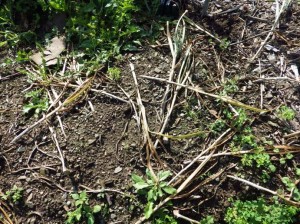 Although we really are coming into our gardening season where the veggies are really starting to produce, produce, produce, there are a couple of things which are starting to wind things down.
Although we really are coming into our gardening season where the veggies are really starting to produce, produce, produce, there are a couple of things which are starting to wind things down.
Like this bit of plot at the back of one of the garden beds. Well, this looks pretty pathetic, doesn’t it? This, my friends, is garlic ready for harvest. It is the first of four varieties that we are trialing here at Chez Siberia (because if it will grow here, it will literally grow anywhere), Susanville. Now, in the catalogs, this is referred to as a ‘mid-season’ garlic, but it’s died back very early here. This growing season (and for garlic, as you recall, we planted the cloves last fall, so the growing season went through the winter and our very chilly and wet spring as well) has been very challenging. Although the garlic was under heaps of snow during the winter, it still was extremely cold (minus 27 degrees F. a couple of times) and we got a couple of late frosts in the spring. So, we are very curious to see how all of the garlics handled the non-perfect growing conditions.
We planted, as a test, 8 ounces (half a pound) of each of four varieties. Now, garlic varieties will vary not only in terms of sizes of the bulbs but also in the number of cloves in each bulb. Some varieties tend toward a bulb with a few large cloves and some have lots and lots of small cloves and some are in between and some have a mix of large and small cloves. To be frank, when I was planting, I used any truly small cloves to cook with because they do not grow well in the garden. But, in general, I planted the same amount, BY WEIGHT, of each variety.
Now, the process of garlic dying down so that we can harvest pretty much starts out looking a bit like this photo here. 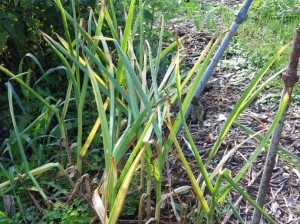 The leaves start to turn yellow and then dry up. If the garlic is a ‘soft-neck’ type, the stem will collapse where it meets the bulb and fall over which is a very neat and tidy way to know that it’s ‘done’. ‘Hard-neck’ types produce an inner hard dry stem; when that is completely dry, hard and white, then those garlics are finished. This variety is just starting the process of dying back. It will probably take several weeks (depending on the weather; if we have chilly and wet weather, this will take longer) to completely die down.
The leaves start to turn yellow and then dry up. If the garlic is a ‘soft-neck’ type, the stem will collapse where it meets the bulb and fall over which is a very neat and tidy way to know that it’s ‘done’. ‘Hard-neck’ types produce an inner hard dry stem; when that is completely dry, hard and white, then those garlics are finished. This variety is just starting the process of dying back. It will probably take several weeks (depending on the weather; if we have chilly and wet weather, this will take longer) to completely die down.
Garlic is not the only plant that is starting the process of dying back. The onions are, as well. 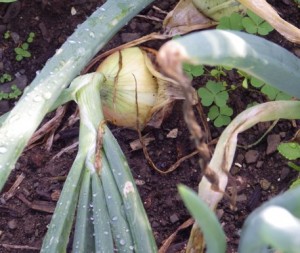 Onions, though part of the same family (allium) as the garlics, does it’s thing slightly differently as you can see from this photo. The leaves have not even started to turn color, but the connection between the leaves and the stem (the collar) has collapsed. Once all the onions in the bed have gone through this and the leaves have turned brown and died back, we will dig them up, wash them, dry them and put them into storage.
Onions, though part of the same family (allium) as the garlics, does it’s thing slightly differently as you can see from this photo. The leaves have not even started to turn color, but the connection between the leaves and the stem (the collar) has collapsed. Once all the onions in the bed have gone through this and the leaves have turned brown and died back, we will dig them up, wash them, dry them and put them into storage.
Harvesting the garlic goes pretty much the same way. We dig them up, knock the dirt off them, rinse them off, let them dry in a dry place. Now, because this is a trial, what we will also do is cut off all the dead foliage and weigh the bulbs, recording the total weight. We will then select the 5 or 6 biggest (by eye) bulbs, weigh those and pick the 3 largest bulbs and save those for seed (now this is all depending on how the other three varieties do). The other garlic cloves, I will wash again, peel, stick into plastic bags and freeze for use through the next year.
What else is going on in the garden? Well, something interesting that is NOT happening is this: rabbits and woodchucks do NOT like chard. They nibbled down the kohlrabi and pak choi this year but the chard has gone untouched. 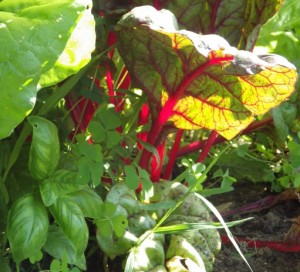 And yes, that IS basil tucked in there. We ended up with tons of basil seedlings and I stuck them wherever I could find a spot. Always neat to find a nice basil plant while we’re out picking in the garden because the leaves are so aromatic.
And yes, that IS basil tucked in there. We ended up with tons of basil seedlings and I stuck them wherever I could find a spot. Always neat to find a nice basil plant while we’re out picking in the garden because the leaves are so aromatic.
Another item at this point which we have to race to keep up with are the cucumbers. Like all members of the squash, melon and curcubit family, once cucumbers start to really produce, you have to check them literally on a daily basis (they are not as bad as zucchini in that regard but you still need to keep after them. Thank goodness I’ve found some really neat recipes to use cucumbers for, including refreshing smoothies and drinks. 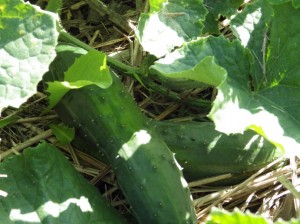
This year, a lot of garden space is being taken up with peppers. The sweet peppers have not done very well this year (probably due to the chilly and wet spring), but the hot peppers (I started a hot pepper mix, so don’t ask me what this photo is of besides a purple hot pepper) have done amazingly well, flowering early, setting little peppers and just going crazy out there. Because this is a mix, we’ve got purple plants producing purple peppers and green plants producing green peppers and goodness knows what will happen this month. After all, it is only August 1, which means that we’ve got, at the worst, 6 weeks of warm weather to have them grow big, fat and whatever color they are supposed to be. At the best, we will have 8 weeks for sure and perhaps even 9 or 10. I’m very excited because the plan for these babies is for us to make hot sauce, bottle it and give it as holiday gifts. We’ll see how that goes.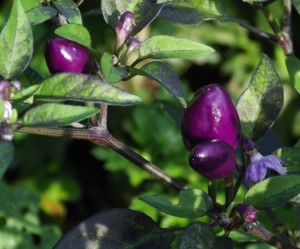
Something else that is different about this year’s garden is that we are not only trialing garlic varieties, but also trialing various perennials. So, I’m using parts of the garden beds (which usually have vegetables) to grow the plants and see how they handle the weather this winter. We’ve got wild lupins and painted daisies, shorter versions of shasta daisies and a few other things. One group which is doing extremely well are the gaillardias and rudbeckias, which I’m very happy to see, since they are tough and colorful and once they get going in terms of flowering, they will keep flowering until the frosts come. Which means that we will get our money’s worth out of them as decorative items which will have pollen and necter for the bees and other pollinators.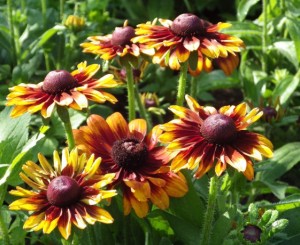
So, there you have it; have a terrific week. Remember to eat something GREEN!!
